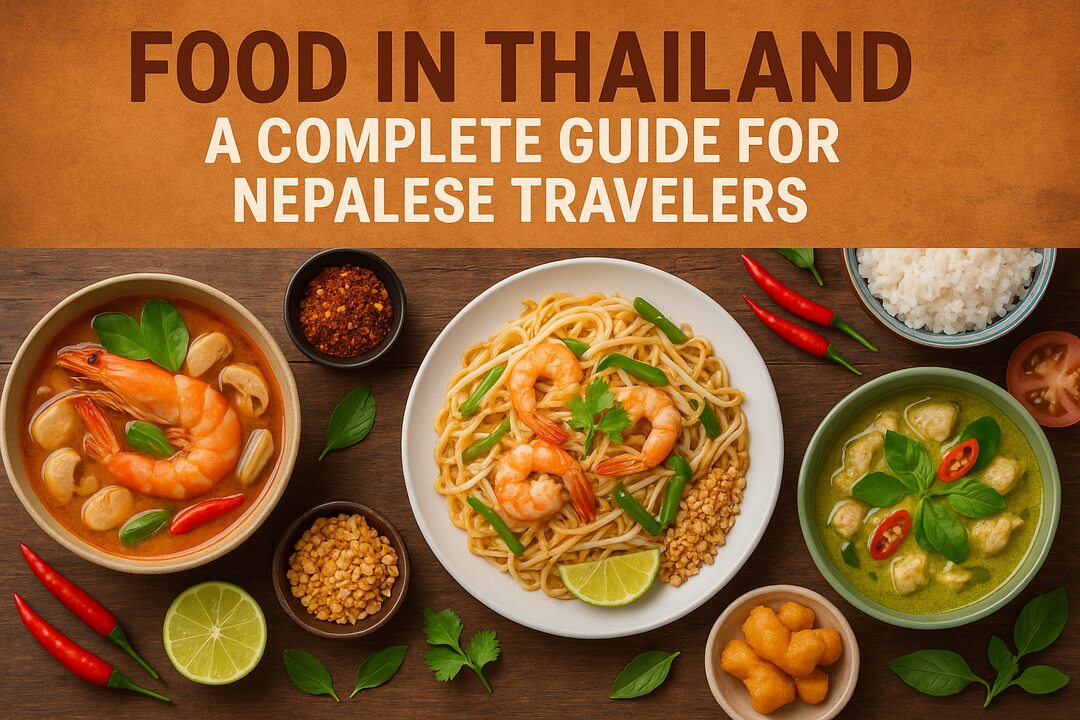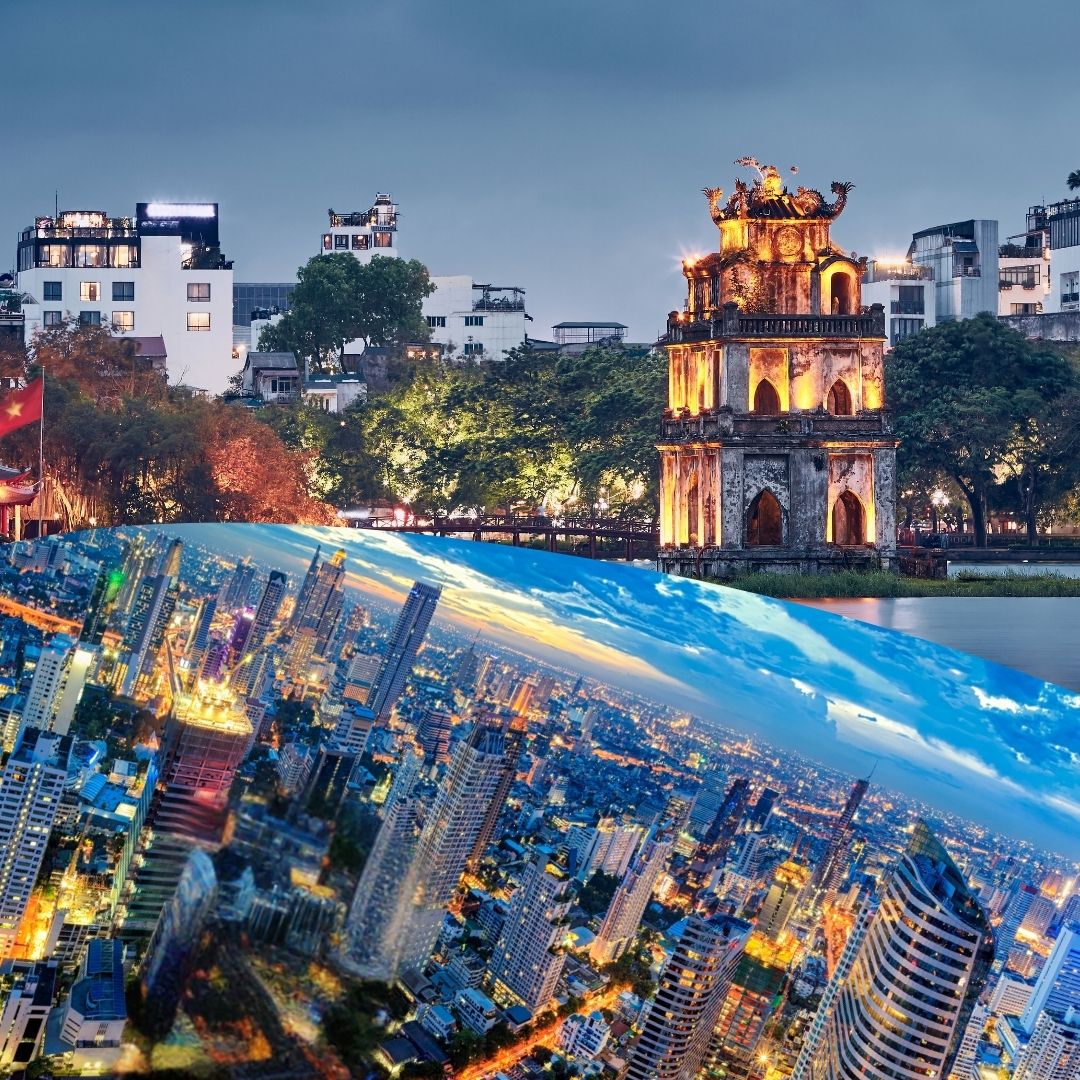Thailand is not just famous for its beaches, temples, and nightlife. It’s also known for something truly amazing: food in Thailand! If you’re a Nepali traveler heading to Thailand, get ready for a delicious adventure that goes far beyond your regular Nepalese Cuisine.

Food in Thailand is a fun mix of flavors from sweet, spicy, salty, and sour, all blended in a way that feels exciting and new. From tasty street snacks to rich curries and tropical fruits, every meal is a new experience. Whether you’re a vegetarian looking for safe options, a foodie craving authentic local taste, or someone searching for comfort food that reminds you of home, this guide is here to help you.
Table of Contents
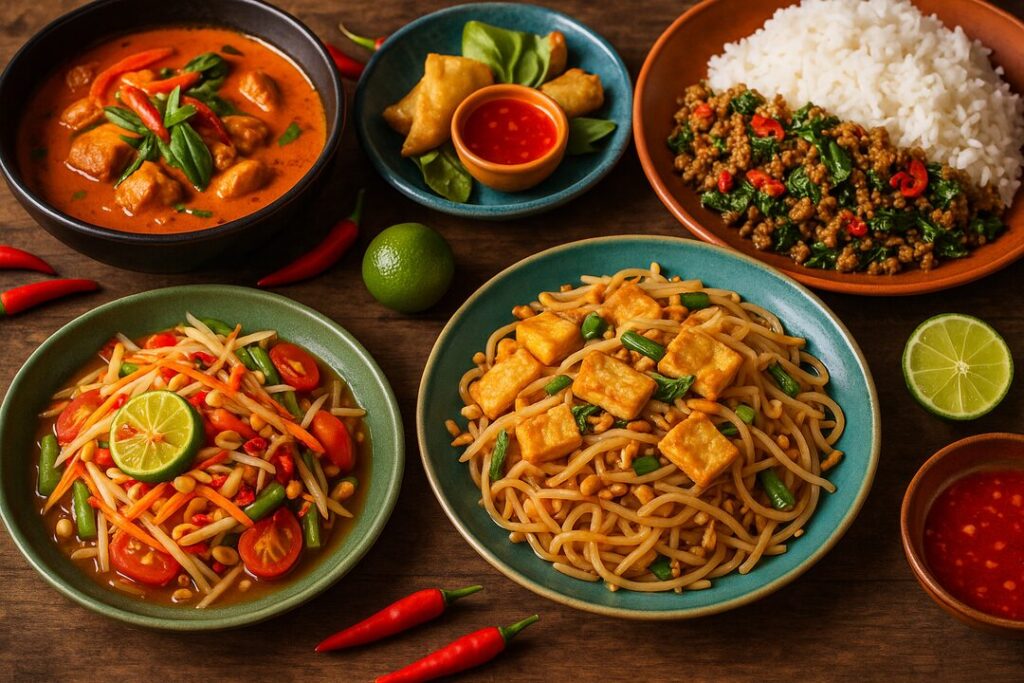
At Gomayu Travel Agency, we’ve created this complete guide to food in Thailand just for you, our Nepalese travelers. Do checkout our Thailand Packages and book it, if you may like. From the busy food markets of Bangkok to seafood stalls by the beaches in Phuket, you’ll discover everything you need to eat well, eat safe, and enjoy every bite on your trip.
Let’s dive into the world of Thai flavors!
What Makes Food in Thailand So Special?
Before we share what dishes to try and where to find the best bites, it’s important to understand what makes Thai food so unique and why it’s so loved all around the world.

Here’s what gives Thai food its signature charm:
- Fresh herbs and spices: Lemongrass, Thai basil, galangal (like ginger), kaffir lime leaves, and chilies add life to every dish.
- Fish sauce (Nam Pla): This salty, savory sauce is like the secret ingredient in many dishes, similar to how we use fermented flavors in Nepali cuisine.
- Coconut milk: This creamy base balances out spicy curries and gives desserts a rich, smooth flavor.
- Vibrant veggies and fruits: Thai food is colorful and fresh crunchy veggies and juicy tropical fruits are used in main dishes, sides, and even desserts.
- Jasmine rice: Just like in Nepal, rice is a big deal. But in Thailand, it’s usually fragrant jasmine rice that pairs beautifully with everything from stir-fries to curries.
If you’re used to slow-cooked, hearty Nepali meals, food in Thailand might feel lighter and fresher, but it’s packed with flavor and just as satisfying. Once you taste that perfect blend of spicy, sweet, sour, and salty, you might find yourself falling in love with Thai food instantly!
Vegetarian Food in Thailand: A Plant-Based Meals
Are you a vegetarian traveler from Nepal wondering, “Can I survive in Thailand without meat?” Don’t worry, not only will you survive, you’ll thrive!

Good news: Vegetarian food in Thailand is easy to find, super flavorful, and beautifully colorful especially in places like Bangkok, Chiang Mai, and the islands where tourists from all over the world gather. Whether it’s for religious reasons or personal choice, if you prefer a plant-based diet, Thailand is ready to welcome you with open arms and a sizzling wok!
How to Find Vegetarian Food in Thailand?

Okay, let’s learn a bit of foodie Thai! The magic phrase you’ll want to remember is:
“Gin Jay” (กินเจ) – which means “I eat vegetarian food.”
Another handy phrase:
“Mai gin neua sat” (ไม่กินเนื้อสัตว์) – “I don’t eat meat.”
Just saying these at restaurants (or showing it written on your phone) can open up a world of veggie delights.
Must-Try Vegetarian Dishes in Thailand
Here are some of the yummiest meat-free meals you’ll want to order again and again:
- Pad Pak Ruam: Mixed vegetable stir-fry with garlic and soy sauce. Simple, crunchy, and so satisfying!
- Tom Kha Het : Coconut mushroom soup. Creamy, tangy, and packed with umami, a must-try version of the classic Tom Kha!
- Som Tam Jay: Vegetarian green papaya salad. Zesty, crunchy, and refreshing, just make sure it’s made without fish sauce!
- Pad Thai Jay : Everyone’s favorite Thai noodle dish, made vegetarian! No fish sauce, no meat, just pure deliciousness.
- Gaeng Keow Wan Pak: Green curry with vegetables and coconut milk. Spicy, fragrant, and perfect with a bowl of jasmine rice.
With vegetarian food in Thailand, you’ll never be bored. There are endless variations, and most places are happy to tweak dishes for your dietary needs.
Veggie Potential Challenges

While the veg scene in Thailand is pretty great, there are a few hidden surprises you should look out for:
- Fish sauce (Nam Pla): It’s sneaky! This salty sauce is everywhere, even in dishes that look vegetarian. Just say “Mai sai nam pla” (no fish sauce) to stay safe.
- Shrimp paste: Often used in curries and sauces. Ask about it if you’re unsure.
- Meat-based broth: Some soups use chicken or pork stock, even if there’s no visible meat. Best to double-check!
For truly meat-free meals, look for places that serve “Jay” (เจ) food, these are Buddhist vegetarian eateries. You’ll recognize them by the bright yellow flags with red lettering. These restaurants go the extra mile: no animal products and no onion or garlic (which are avoided in Jay cuisine).
Don’t Miss the Vegetarian Festival!
Here’s a bonus! If you’re in Thailand during October, you might get lucky and witness the Vegetarian Festival especially in cities like Phuket and Bangkok’s Chinatown. It lasts for 9 days and transforms the whole place into a vegetarian wonderland!

Food stalls, restaurants, and even non-veg places start offering special Jay menus, making this the best time to explore vegetarian food in Thailand. You’ll find everything from veggie satay to sticky rice sweets, all made without meat, dairy, or eggs.
So yes, being a vegetarian in Thailand is totally doable (and even delightful!). With a few simple phrases, a bit of awareness, and a healthy appetite, you’ll discover that vegetarian food in Thailand isn’t just an afterthought, it’s a full-on foodie adventure.
Best Food in Thailand: Must-Try Dishes for Nepalese
If you’re a foodie from Nepal heading to Thailand, get ready because the best food in Thailand is going to surprise, delight, and maybe even spice up your travel experience! Thai cuisine is famous for its bold flavors, colorful presentation, and a perfect mix of spicy, sweet, salty, and sour.
Even better? Many Thai dishes feel somewhat familiar to us Nepalese especially the rice-based meals, spicy curries, and noodle bowls. So whether you love a kick of chili or prefer something mild and comforting, there’s something waiting for you at every Thai food stall or restaurant.
Rice-Based Meal
Coming from a rice-loving country, it’s no surprise that many of the best food in Thailand for Nepalese travelers begins with rice!

- Khao Pad (Thai Fried Rice)
Think fried rice, but with a Thai twist, fragrant jasmine rice stir-fried with eggs, veggies, and sometimes chicken or seafood. Simple, tasty, and filling! - Khao Man Gai (Thai Chicken Rice)
This one’s a comfort classic. Steamed chicken over aromatic rice served with a flavorful dipping sauce. It’s soft, gentle on the stomach, and great when you’re craving a meal that feels close to home. - Khao Soi (Northern Thai Curry Noodle Soup)
A rich, creamy coconut curry soup with both soft and crispy noodles on top. Popular in Chiang Mai, this dish is a must-try for travelers who like bold yet smooth flavors.
Curries
If you’re curious about how Thai curries compare to our Nepali ones, you’re in for a flavorful ride! Some of the best food in Thailand comes in a bowl of curry.
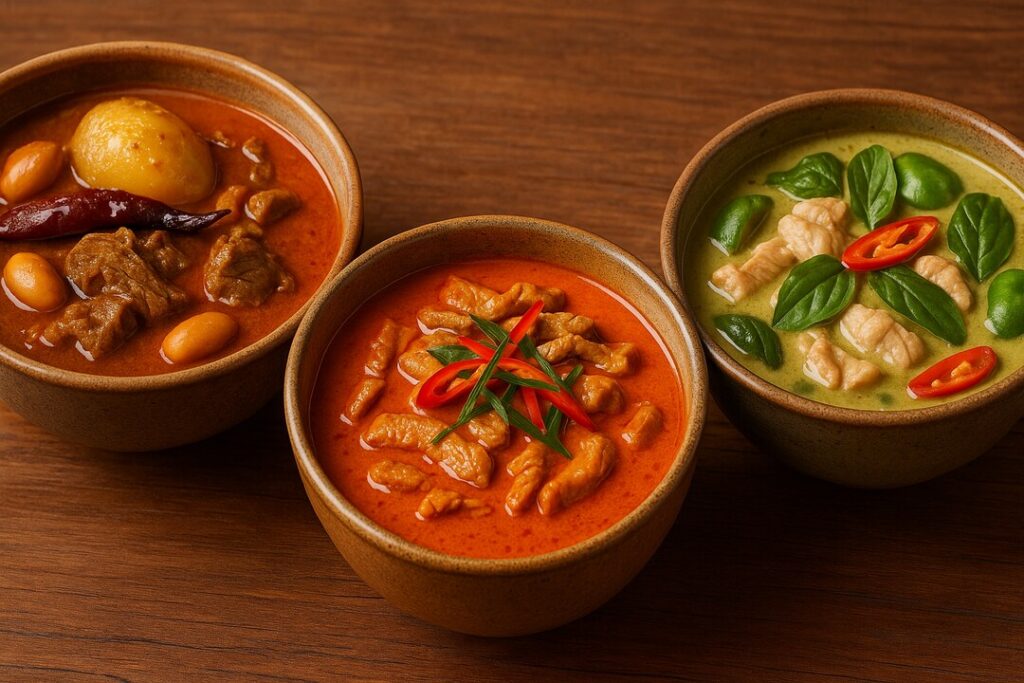
- Massaman Curry
Mild and mellow, this curry features potatoes, peanuts, and meat, something that might feel close to our chicken curry but with a sweet-and-savory twist. - Panang Curry
Creamy and rich, this dish is a bit thicker and sweeter than most. Great for those who like flavor-packed curries without too much heat. - Green Curry (Gaeng Keow Wan)
Spicy, fresh, and aromatic! This is for those who love heat and herbs in their meals. It’s bold, green, and unforgettable.
Noodles
On the move? Don’t miss these noodle dishes, quick to serve and big on flavor. Many travelers say the best food in Thailand is what they grab from a roadside vendor!

- Pad Thai
Probably the most famous Thai dish out there, stir-fried rice noodles tossed with egg, tofu, veggies, peanuts, and sometimes shrimp or chicken. Sweet, tangy, nutty, all in one bite! - Pad See Ew
A great option if you prefer something more savory than sweet. Flat noodles stir-fried with soy sauce, broccoli, and your choice of protein. Comfort food at its finest! - Boat Noodles (Kuay Teow Reua)
Rich, dark, and packed with flavor. These noodles are cooked in a broth often made with beef or pork, perfect if you’re craving something meaty and intense.
Spicy Meals
If you love achars and spicy foods back home, you’ll love these fiery favorites definitely part of the best food in Thailand for chili lovers!

- Tom Yum Goong
A hot and sour soup with prawns, lemongrass, lime, and chili. Every spoonful is a burst of flavor! - Nam Prik
A variety of chili dips served with veggies or fried items. Feels a bit like our Nepali achar game but with a Thai personality! - Som Tam (Green Papaya Salad)
Crunchy, spicy, tangy, and a little sweet this salad is both refreshing and fiery. Order the “Som Tam Thai” version if you want it slightly less spicy.
Thai Seafood Specials
Since Nepal is a landlocked country, seafood isn’t always a big part of daily meals but Thailand’s coastal cities offer some of the best food in Thailand straight from the sea!
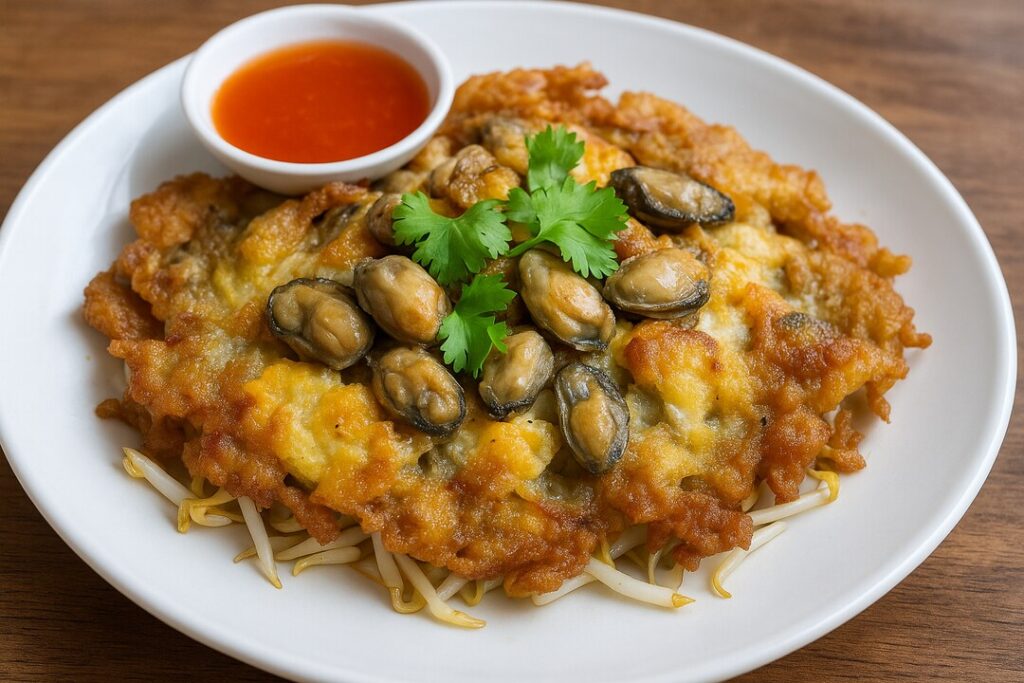
- Pla Kapung Neung Manao
A steamed whole fish in lime, garlic, and chili sauce, light, healthy, and full of zing. - Hoy Tod (Oyster or Mussel Omelette)
Crispy and savory, this street-food favorite gives you a taste of Thai seafood in a totally new way. - Goong Pad Prik Gaeng
Stir-fried shrimp with red curry paste, spicy, aromatic, and perfect with a bowl of rice.
There’s Something for Everyone!
Whether you love spice or prefer mild dishes, are vegetarian or a meat lover, the best food in Thailand has something for every kind of Nepalese traveler. It’s not just about trying something new, it’s about discovering flavors that feel both exciting and surprisingly comforting.
Indian Food in Thailand
After a few days of spicy Thai curries and noodles, many Nepalese travelers start craving something closer to home and that’s where Indian food in Thailand comes to the rescue. With deep cultural and culinary ties between Nepal and India, it’s no surprise that Indian cuisine feels like a warm hug for many Nepalese visitors.
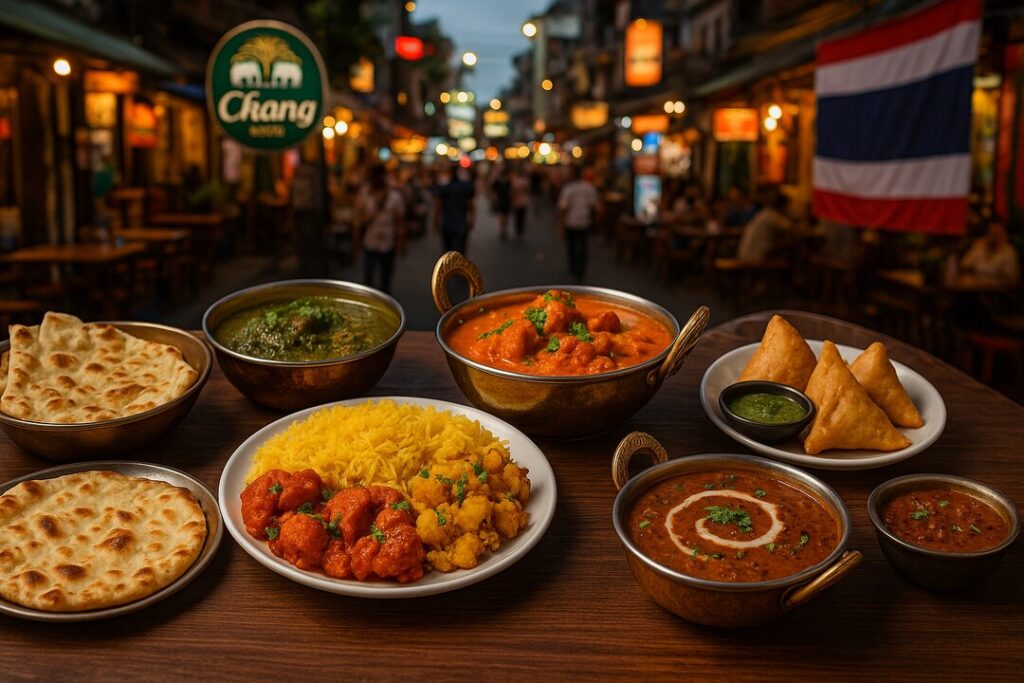
The best part? Indian food in Thailand is widely available, especially in cities like Bangkok, Phuket, Pattaya, and Chiang Mai. Whether you’re after a budget-friendly thali or a fine-dining Mughlai feast, you’ll find plenty of delicious options.
Where to Find Indian Food in Thailand?
If you’re wondering where to go for a comforting plate of curry and naan, you’ll be happy to know that Indian food in Thailand is concentrated in areas with lots of tourists and expats.
- Bangkok: Head to Sukhumvit Road, especially near Soi 11 and the Nana area. This part of the city is a hub for Indian cuisine with options ranging from luxury dining to affordable street-style eateries.
- Phuket & Pattaya: Beach destinations with a strong South Asian tourist presence, meaning plenty of Indian restaurants too.
- Chiang Mai: Even in northern Thailand, you’ll find cozy spots serving up flavorful Indian meals.
Top Indian Restaurants to Try
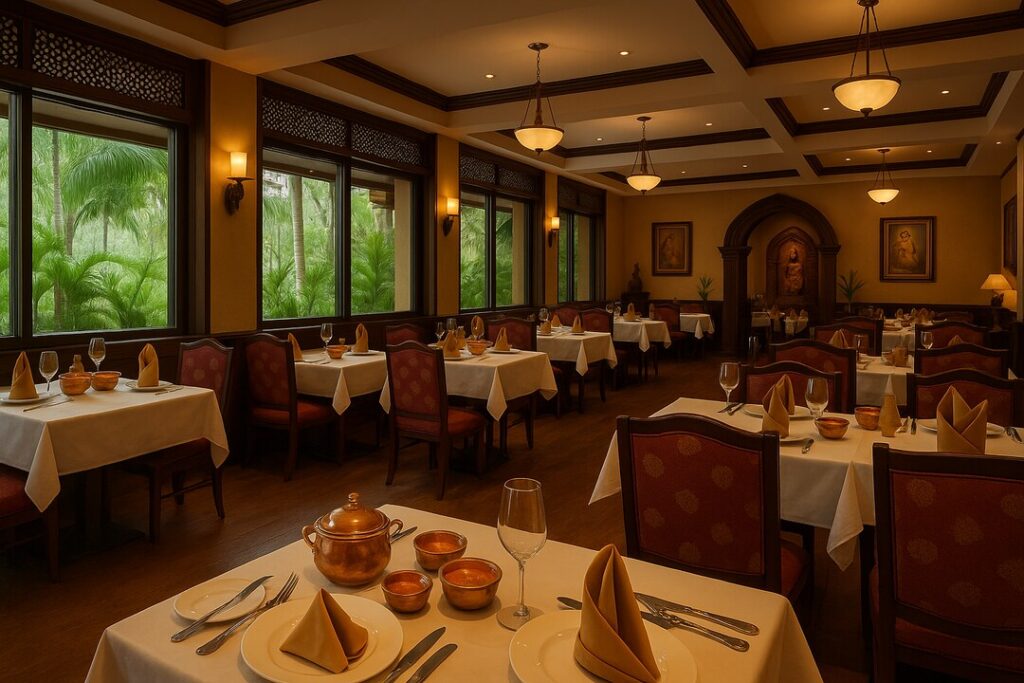
Some popular spots for Indian food in Thailand that consistently receive good reviews include:
- Gaggan (Bangkok): World-famous for its modern take on Indian food. Perfect for a special night out.
- Punjab Grill (Bangkok): Known for its elegant North Indian dishes and rich flavors.
- Indus (Bangkok): Serves up Mughlai and North Indian cuisine in a refined setting.
- Dosa King: With multiple branches, it’s a reliable choice for authentic South Indian food like dosas, idlis, and vadas.
- Royal India (Phuket): A go-to restaurant offering all the classics in a more relaxed setting near the beach.
No matter where you are, there’s always a good spot for Indian food in Thailand just a short ride away.
Classic Indian Dishes You’ll Find

Most Indian restaurants in Thailand serve a familiar lineup of crowd-pleasers that feel like home:
- Butter Chicken, Palak Paneer, Chicken Tikka Masala
- Biryani
- Dal Makhani, Chana Masala, Aloo Gobi
- Naan, Roti, Paratha
- Samosas, Paneer Tikka, Chaat
Whether you’re traveling solo or with family, these dishes make Indian food in Thailand feel just like home.
Cooking at Home? Indian Groceries Are Available

If you’re staying longer and have access to a kitchen, you’ll be glad to know you can cook your own Indian food in Thailand! Major supermarkets like Big C, Tesco Lotus, and Villa Market stock basic Indian spices, rice, lentils, and even frozen naan.
There are also Indian grocery stores in Bangkok and Pattaya where you can buy everything from cumin and garam masala to basmati rice and ghee.
Craving something familiar while traveling?
Indian food in Thailand offers the perfect escape when you’re looking for a break from Thai flavors. With a mix of traditional dishes, fusion innovations, and availability across all major tourist hubs, it’s easy to find meals that satisfy both your stomach and your soul.
Cost of Food in Thailand
When planning your trip to Thailand, one of the most important things to consider is your daily food budget. The great news? The cost of food in Thailand is surprisingly affordable especially if you know where (and how) to eat! Whether you’re craving flavorful street food, comfort meals at a local restaurant, or a fancy dinner out, Thailand has something for every appetite and every budget.
Let’s break it down so you can enjoy every bite without worrying about overspending.
Street Food

If you’re looking to stretch your budget and still eat like a king, street food is where it’s at. The cost of food in Thailand from roadside vendors is incredibly low, and the flavors are anything but cheap!
Typical prices:
- Pad Thai: 40–60 THB
- Som Tam (Papaya Salad): 40–60 THB
- Khao Pad (Fried Rice): 40–60 THB
- Moo Ping (Grilled Pork Skewers): 10–20 THB each
- Fresh Fruit: 20–40 THB per serving
That’s around 100–230 NPR per meal, making it super budget-friendly for Nepalese travelers.
Local Restaurants & Food Courts

Want a sit-down meal in a relaxed space? Head to local restaurants or food courts (especially in shopping malls). The cost of food in Thailand here typically ranges from 80–200 THB (approx. 260–650 NPR) per person. You’ll enjoy:
- Air-conditioned seating
- Wider food choices (Thai, Chinese, Indian, Western)
- Hygienic conditions with good service
- Most food courts use prepaid cards, making payment simple and efficient.
Luxury Dining

If you’re celebrating a special occasion or want to enjoy a gourmet night out, upscale restaurants deliver quality and ambiance. The cost of food in Thailand at high-end places usually starts at 300–500 THB (980–1,630 NPR) per person, though fine dining venues can go much higher. This includes:
- Rooftop restaurants in Bangkok
- International cuisines (Italian, Japanese, Indian)
- Premium Indian restaurants like Gaggan, Punjab Grill, and Indus
- Great for romantic dinners or family celebrations!
Regional Differences in Food Costs
Keep in mind that the cost of food in Thailand also depends on where you are:
| Location | Food Cost Trend (per day) | Highlights |
| Bangkok | 40–2500 Bhat | Huge variety – from street eats to fine dining |
| Tourist hotspots (Phuket, Koh Samui) | 50-3000 Bhat (20–30% higher) | Popular areas = higher prices |
| Northern Thailand (Chiang Mai, Pai) | 30-2000 Bhat | Cheaper and more local-focused |
| Rural towns & non-tourist zones | 50-1000 Bhat | Lowest food prices, but fewer global options |
Smart Tips to Save on Food Costs
If you’re traveling on a tight budget, here are a few smart ways to reduce your cost of food in Thailand without missing out on flavor:
- Eat where locals eat: Busy local spots usually mean better food and better prices.
- Visit fresh markets: Like Or Tor Kor Market in Bangkok: great food, great prices.
- Stay in hotels with breakfast included: Fills you up for the day and saves on one meal.
- Look for lunch deals: Many restaurants offer cheaper set menus during lunch hours.
Use convenience stores: 7-Eleven and Family Mart offer surprisingly good meals (microwaved rice boxes, sandwiches, and even sushi!) for as little as 30–70 THB.
Plan, Eat & Enjoy!
Understanding the cost of food in Thailand helps you plan smarter and travel happier. From delicious 40 THB street snacks to fancy rooftop dinners, there’s room for both frugality and indulgence. For Nepalese travelers, Thailand offers a world of taste without breaking the bank so go ahead, explore with your stomach!
Must-Try Food in Thailand
If you’re a Nepalese traveler visiting Thailand, your adventure isn’t complete without diving into the local flavors. From fiery street food to soothing coconut curries, the must-try food in Thailand offers a whole world of taste that’s exciting, diverse, and often surprisingly familiar.
Here’s your ultimate guide to the must-try food in Thailand that captures the heart of Thai cuisine whether you’re in bustling Bangkok, laid-back Chiang Mai, or island-hopping in the south.
Iconic Thai Dishes
These classics are famous worldwide and top the list of must-try food in Thailand:
- Tom Yum Goong
A bold, hot and sour shrimp soup made with lemongrass, kaffir lime leaves, galangal, lime juice, and chili. It’s a true explosion of flavors. - Pad Thai
Stir-fried rice noodles with egg, tofu or shrimp, peanuts, and bean sprouts. The sweet-sour-savory balance makes this one of Thailand’s most loved dishes. - Som Tam (Green Papaya Salad)
Shredded unripe papaya tossed with lime juice, chili, garlic, tomatoes, and peanuts. Fresh, spicy, crunchy it’s Thai food at its most vibrant.
These dishes are widely available and a great introduction to the must-try food in Thailand for first-timers.
Regional Specialties Worth Exploring
Thai cuisine is deeply regional. Here’s a look at the must-try food in Thailand by area each bringing something unique to the table.
Northern Thailand
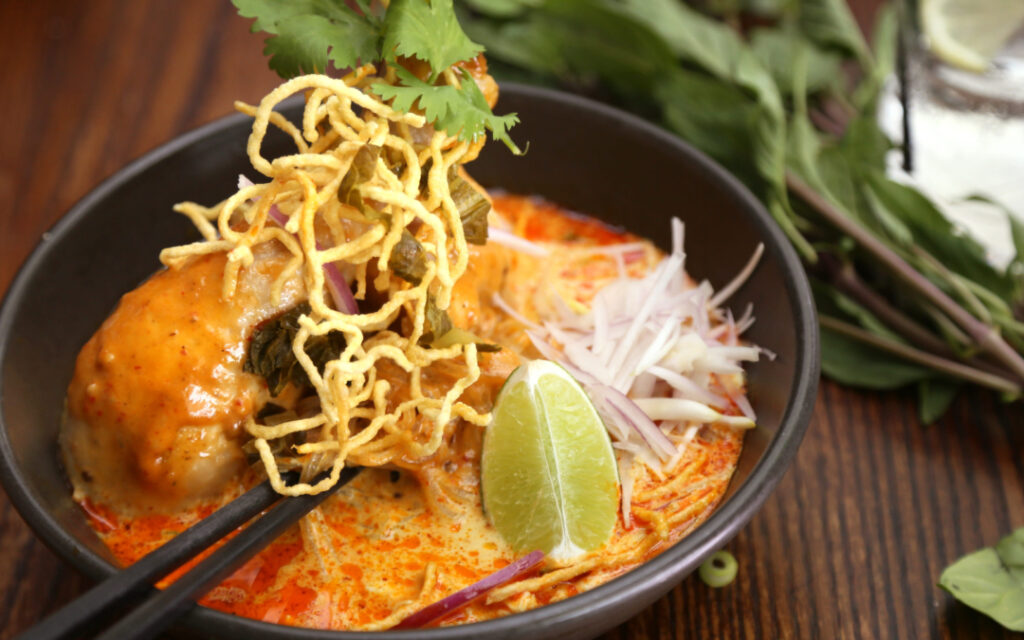
- Khao Soi: A rich, creamy curry noodle soup topped with crispy noodles.
- Sai Oua: Northern Thai sausage packed with herbs like lemongrass and kaffir lime.
- Nam Prik Ong: A mild chili dip made with tomatoes and minced pork, served with veggies.
Isan (Northeastern Thailand)
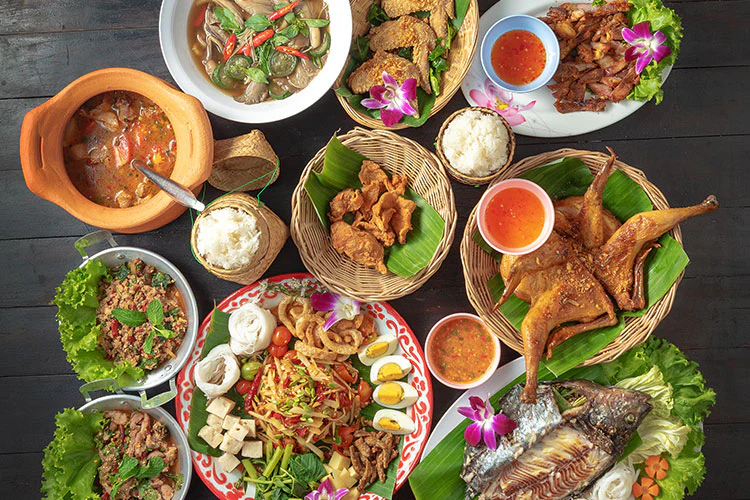
- Larb: A tangy minced meat salad flavored with lime, mint, and roasted rice powder.
- Gai Yang: Grilled chicken marinated in garlic, coriander, and fish sauce.
- Som Tam Poo Plara: A bolder, fermented version of papaya salad with crab.
Central Thailand

- Massaman Curry: A mild curry with potatoes and peanuts, perfect for those easing into Thai spice.
- Tom Kha Gai: A creamy coconut chicken soup with galangal and lime — comforting and flavorful.
- Hoy Tod: A sizzling oyster or mussel omelet that’s crispy on the outside and soft inside.
Southern Thailand

- Gaeng Tai Pla: A strong, salty curry made with fermented fish paste intense and bold!
- Khua Kling: Spicy dry-fried meat with southern herbs.
- Pla Thot Kamin: Deep-fried fish marinated in turmeric crispy and golden.
If you’re adventurous with food, these regional dishes are some of the most authentic must-try food in Thailand.
Unique Must-Try Food in Thailand for the Brave Eater

Looking to push your culinary limits? Here are some unusual (but delicious) dishes that define the daring side of must-try food in Thailand:
- Kai Yiew Ma (Son-in-law Eggs): Fried hard-boiled eggs with tangy tamarind sauce.
- Yam Pla Duk Foo: Fluffy catfish salad made from crispy fried shredded fish.
- Goong Ten (Dancing Shrimp): Yes, it’s live shrimp. Yes, they’re still “dancing” in spicy sauce. Only for the brave!
- Khao Yam: A southern-style rice salad with herbs, vegetables, and fish sauce.
Thai Desserts You Shouldn’t Miss
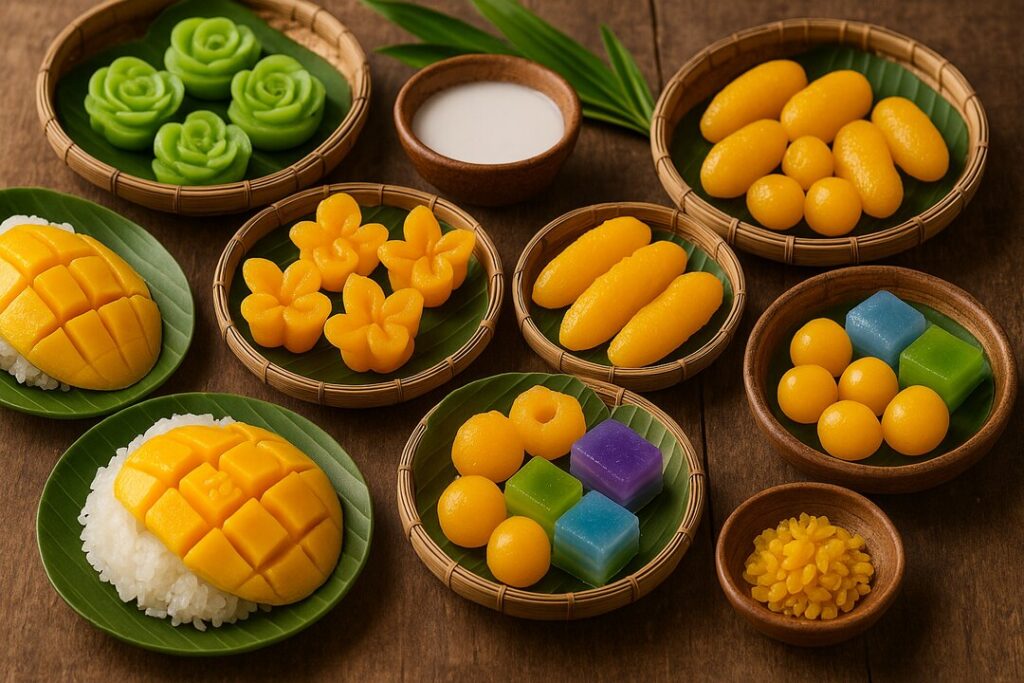
Even dessert is part of the must-try food in Thailand! After all that spice, these sweet treats offer the perfect cool-down:
- Mango Sticky Rice: Sweet sticky rice with ripe mango and coconut cream. A Thai classic!
- Khanom Buang: Crispy pancakes filled with whipped coconut cream and sweet or salty toppings.
- Tub Tim Grob: Water chestnuts in coconut milk. Crunchy, creamy, and refreshing.
- Khanom Chan: A rainbow-colored layered coconut pudding that’s fun to eat and lovely to look at.
From spicy soups and grilled meats to tropical desserts and regional surprises, the must-try food in Thailand offers something for every type of traveler. For Nepalese visitors, it’s a chance to explore new flavors while occasionally finding tastes that feel comfortingly familiar.
Street Food in Thailand
If you’re a Nepalese traveler exploring Thailand, there’s one experience you simply can’t miss, tasting street food in Thailand! From sizzling woks to grilled skewers, the street food culture here is a feast for the senses. It’s more than just a meal, it’s a deep dive into everyday Thai life.
Let’s help you navigate the colorful, flavorful world of street food in Thailand, where to find it, what to try, and how to enjoy it safely.
What is Street Food in Thailand?

Thailand’s street food is legendary and for good reason! It’s everywhere, it’s affordable, and most importantly, it’s incredibly delicious. Here’s where you’ll typically find it:
- Street Vendors: Small carts parked along sidewalks selling 1–2 specialty dishes, from Pad Thai to grilled meats.
- Food Markets: Crowded areas filled with dozens of food stalls, each offering something different.
- Food Courts: Found in malls or transit hubs, these offer a more organized way to sample street food in Thailand with indoor seating.
- Night Markets: Open in the evenings, these buzzing markets combine food, shopping, and music for an all-out cultural experience.
Whether you’re in a bustling city or a quiet coastal town, street food in Thailand is always close by.
Must-Try Street Food in Thailand for First-Timers
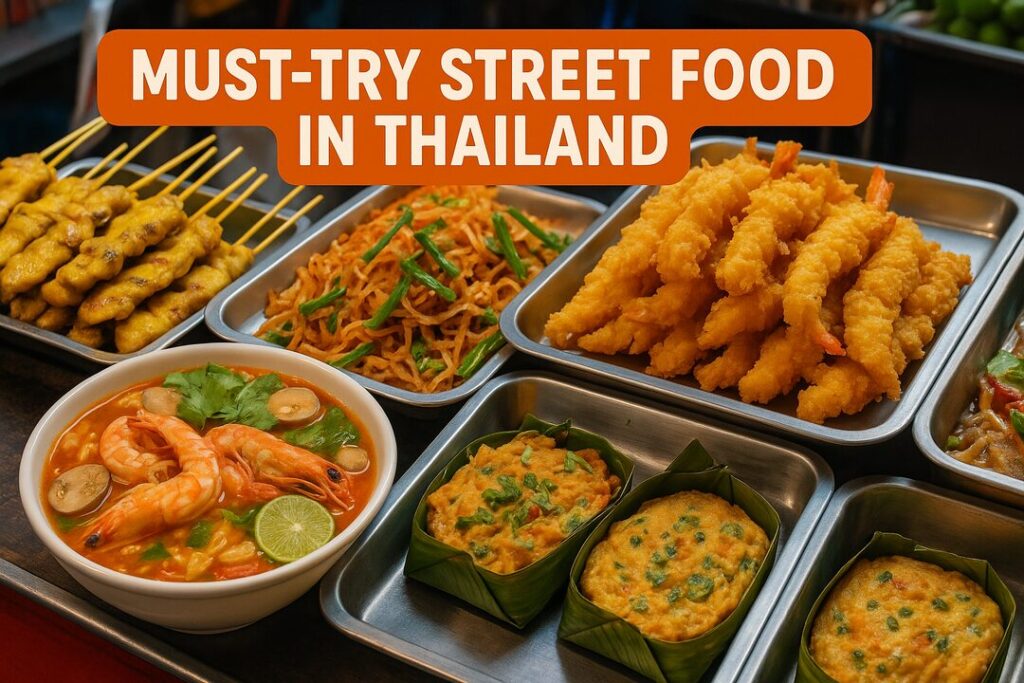
New to Thai flavors? Start with these easy, flavorful options great for Nepalese:
- Pad Thai: Stir-fried rice noodles with egg, tofu, peanuts, and your choice of meat or shrimp. Made fresh in front of you!
- Satay: Marinated grilled meat skewers (usually pork or chicken) served with a creamy peanut sauce.
- Moo Ping: Juicy grilled pork skewers with a sweet-savory glaze. Add sticky rice on the side!
- Khao Pad: Thai fried rice, simple, hearty, and super satisfying.
- Gai Tod: Crispy fried chicken, seasoned Thai-style. A perfect street snack!
- Roti: Thin pancakes (sweet or savory), often topped with banana and condensed milk. Reminds many Nepalese travelers of our paratha!
- Fresh Fruit: Slices of mango, pineapple, papaya, or watermelon often served with a mix of sugar, salt, and chili.
These dishes are flavorful yet approachable, making them the perfect intro to street food in Thailand.
Street Food Safety Tips for Nepalese Travelers
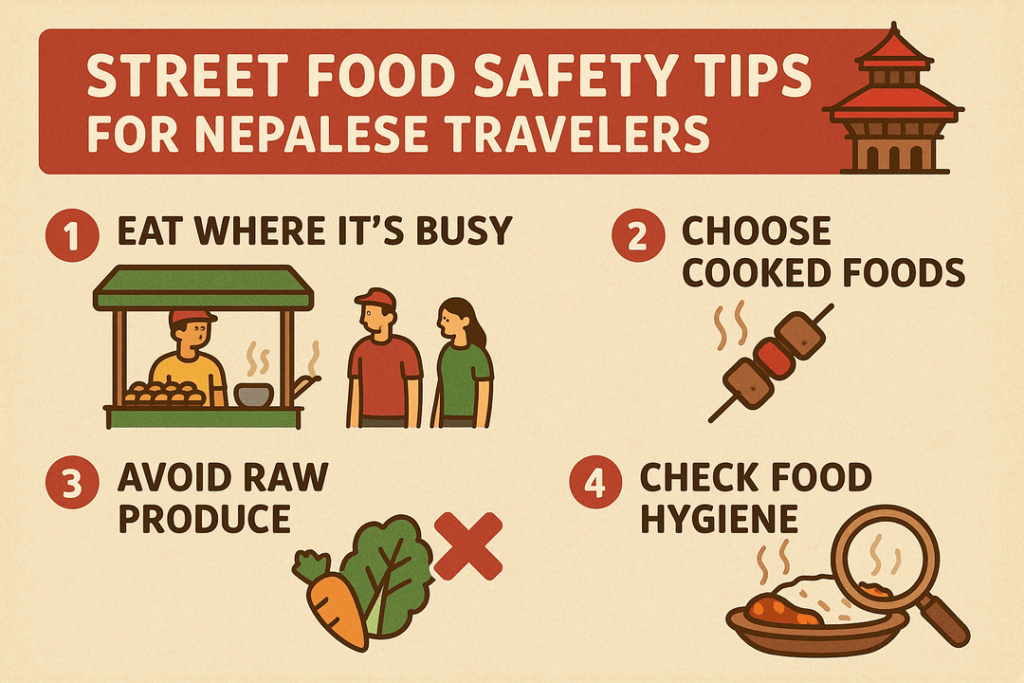
While most street food in Thailand is safe, a few simple precautions can ensure a smooth foodie experience:
- Go where locals go: Busy stalls = high turnover = fresher food.
- Watch how it’s cooked: Choose vendors who cook on the spot and keep things clean.
- Start with hot food: Cooked meals are generally safer than raw or chilled items.
- Use hand sanitizer: Especially before snacking with your hands.
- Avoid ice from unknown sources: Stick to bottled drinks and sealed water.
- Stay hydrated: Spicy dishes can sneak up on you, always have water handy!
- When enjoyed smartly, street food in Thailand is both safe and unforgettable.
Best Places to Try Street Food in Thailand
Some cities offer legendary street food experiences. Here are must-visit spots:
Bangkok:
- Chinatown (Yaowarat): A night market paradise, especially for seafood lovers.
- Wang Lang Market: Known for southern Thai dishes and riverfront vibes.
- Or Tor Kor Market: Clean, high-end, and full of ready-to-eat treats.
- Chatuchak Weekend Market: A giant maze of shopping and tasty bites.
Chiang Mai:
- Chang Phuak Gate Night Market: Try the iconic stewed pork leg from the famous “Cowboy Hat Lady.”
- Sunday Walking Street: Street food meets souvenirs in this weekend hotspot.
Phuket:
- Phuket Weekend Night Market: A vibrant evening market with local eats galore.
- Bangla Road Food Carts: Great for late-night snacks after exploring the nightlife.
No matter where you are, these spots show off the best of street food in Thailand.
Exploring street food in Thailand is one of the most authentic ways to connect with the local culture. It’s not just about what’s on the plate it’s about the sizzling sounds, the smoky aromas, the smiles from street vendors, and the shared joy of food.
So, grab a skewer, pull up a stool, and enjoy the ride because Thai street food is more than a meal.
Food for Nepalese in Thailand
Even the most adventurous travelers from Nepal sometimes find themselves missing the flavors of home warm dal, spicy achar, comforting thukpa, and of course, momos. The good news? It’s becoming easier to find food for Nepalese in Thailand, especially in popular tourist areas where the Nepali community and South Asian influences are growing.
Whether you’re in Bangkok, Pattaya, or Phuket, there are options for enjoying familiar meals or even recreating them yourself during a longer stay.
Nepalese Restaurants Serving Authentic Food for Nepalese in Thailand
While not as common as Indian restaurants, dedicated Nepalese eateries are popping up in Thailand’s major cities offering real Nepali food, cooked by Nepali chefs who know exactly what comfort tastes like.
Bangkok:
- Himalaya Restaurant: Known for its flavorful momos, rich thukpa, and full dal-bhat sets.
- Everest Kitchen: A cozy place serving both Indian and Nepalese dishes, with Himalayan touches.
These places offer a satisfying slice of home and are highly rated by fellow travelers who’ve been on the same food hunt. If you’re craving food for Nepalese in Thailand, these restaurants are a great place to start.
Indian Restaurants That Serve Familiar Nepalese-Style Food

Sometimes, food for Nepalese in Thailand can be found even in Indian restaurants especially those operated by North Indian owners. You might not find the exact names on the menu, but the flavors can feel surprisingly close to home:
- Vegetable & meat curries that resemble our traditional chicken or mutton curry
- Dal dishes that hit just the right spot when you’re craving something warm and hearty
- Tandoori items similar to Nepal’s grilled sekuwa
- Naan and roti that pair well with lentils and pickles: just like a comforting meal from home
Pro tip: Ask if they can prepare anything “Nepali-style” you’d be surprised how many places are open to tweaking spice levels and flavors!
Recreating Nepalese Flavors with Thai Ingredients

If you’re staying longer, maybe in an Airbnb or apartment and want to cook, you can recreate the essence of Nepali meals using local ingredients available in Thailand:
- Lentils: Masoor dal and chana dal are widely available at Big C, Tesco Lotus, or Villa Market.
- Spices: Essentials like cumin, turmeric, coriander, chili powder, and garam masala are easy to find in international or Indian stores.
- Rice: Thai rice is different, but jasmine or sticky rice can be a good base for dal-bhat.
- Vegetables: You’ll find all the usual suspects: potatoes, cauliflower, spinach, green beans, onions, and tomatoes.
This is a budget-friendly and soul-satisfying way to enjoy food for Nepalese in Thailand on your own terms.
While you may not find dal-bhat on every corner, the growing Nepalese community and cultural links between Thailand and Nepal have made it easier than ever to enjoy food for Nepalese in Thailand. Whether you’re grabbing a plate of momos in Bangkok, cooking your own comfort food in Chiang Mai, or finding Indian dishes that feel familiar, there’s always a way to taste home even when you’re far away.
Thai Food Etiquette & Dietary Tips
Experiencing food in Thailand is about much more than taste, it’s about culture, connection, and respect. For Nepalese travelers, many aspects of Thai food culture will feel familiar, but there are also a few unique customs that can make your meals more meaningful and enjoyable.
From dining etiquette to handling dietary restrictions, here’s everything you need to know to confidently enjoy food in Thailand like a local.
Table Manners

Understanding a few simple customs can make your dining experience smoother and more respectful while enjoying food in Thailand:
- Utensils: In Thailand, people usually eat with a spoon (right hand) and fork (left hand). Chopsticks are only used for noodle soups. Unlike Nepal, eating with your hands is not common unless you’re in a very casual setting.
- Communal Style Dining: Just like in Nepal, meals are often shared family-style. Everyone takes small portions from the shared dishes to eat with rice not one big scoop on your plate.
- Finishing Your Food: In Nepal, finishing your plate is a sign of appreciation. In Thailand, it’s okay to leave a little bit it shows you’re full, not wasteful.
- Respect for Elders: Elders or honored guests are often the first to serve or eat — a practice Nepalese travelers will recognize and appreciate.
- Compliments: Say “Aroi!” (meaning “delicious!”) to show appreciation. It’s the Thai equivalent of a happy food dance. 😊
- Paying the Bill: Typically, the person who invites pays the whole bill similar to Nepali hospitality.
Understanding these customs shows you’re not just eating food in Thailand, but also respecting the culture behind it.
What to Know?
Food in Thailand also plays an important role in spiritual and religious life. Here are a few tips:
- Offerings at Temples: Never touch or take food left at spirit houses or temples. These offerings are sacred.
- Monks & Morning Alms: If you see Buddhist monks collecting alms in the morning, maintain distance unless you’re participating in the offering.
- Temple Meals: Some temples offer free vegetarian meals. If you join, be respectful follow the locals, stay quiet, and wait your turn.
Navigating Allergies & Food Restrictions in Thailand
Thai cuisine is incredibly diverse, but for travelers with allergies or dietary needs, it’s important to be cautious. Here’s how to safely enjoy food in Thailand with restrictions.

Common Allergens to Watch For:
- Peanuts: Found in dishes like Pad Thai and satay sauces
- Shellfish: Present in curries, stir-fries, and soups
- Fish Sauce (Nam Pla): A key ingredient in many Thai dishes
- Soy & MSG: Used frequently to enhance flavor
Useful Thai Phrases:
- “Chan pae…” = I’m allergic to…
- Peanuts = Tua lisong
- Shellfish = Kung
- Fish = Pla
- Soy = Tua lueang
- MSG = Pong choo rot
Religious restrictions:
- “Mai gin neua” = I don’t eat meat
- “Mai gin moo” = I don’t eat pork
- “Mai gin neua wua” = I don’t eat beef
Tip: Carry an allergy card written in Thai if your allergy is serious.
Halal Options for Muslim Nepalese Travelers

Looking for Halal food in Thailand? No problem!
- Bangkok (Bang Rak area): A vibrant Muslim community with many Halal eateries
- Phuket & Chiang Mai: Popular tourist areas with Halal restaurants and Muslim-friendly food stalls
Look for “Halal” signs in Arabic or Thai
Gluten-Free & Sensitive Diets
Though many Thai dishes are rice-based, some ingredients contain hidden gluten
- Soy Sauce: Often contains wheat. Ask for alternatives or skip sauces.
- Wheat Noodles & Thickened Sauces: Choose rice noodles or clear broths instead.
Say: “Mai gin paeng” = I don’t eat flour/wheat
When in doubt, stick to curries, steamed rice, grilled meat, and fresh vegetables, simple and safe!
Managing Spice in Thai Food
Food in Thailand is known for its bold spice, but if you’re sensitive, communicate clearly:
- “Mai pet”: Not spicy
- “Pet nit noi”: A little spicy
- “Pet maak”: Very spicy
Fun Fact: Thai “not spicy” may still feel hot to Nepalese travelers so always test your limits gently!
Eating food in Thailand is more than just enjoying the amazing flavors, it’s about honoring the people, traditions, and culture that make it special. By understanding dining etiquette and knowing how to manage dietary needs, Nepalese travelers can enjoy a rich and respectful food journey through the Land of Smiles.
Bringing the Flavors of Food in Thailand Back to Nepal
So, you’ve explored bustling night markets, devoured street snacks, and fallen in love with Thai curries. Now what? Why not bring a piece of that delicious journey back with you?
For Nepalese travelers, packing up some tasty food in Thailand to enjoy at home or to share with friends and family is one of the best ways to extend your travel experience. And guess what? Thai food souvenirs are easy to find, beautifully packaged, and full of flavor!
Packaged Thai Goodies to Take Home

Here’s a list of the most popular food in Thailand that travels well and makes perfect edible souvenirs:
Pastes & Sauces
- Green, Red & Massaman Curry Pastes: Vacuum-sealed, long shelf life, and super easy to use.
- Nam Prik Pao (Chili Jam): Sweet, smoky, spicy… the ultimate Thai flavor booster.
- Pad Thai Sauce: Skip the guesswork and recreate that street food magic at home.
- Fish Sauce: The backbone of Thai flavor. Available in travel-friendly bottles (just seal it tight!).
Snacks & Sweets
- Thai Tea Mix: Recreate that orange, creamy Thai iced tea in your own kitchen.
- Khanom (Thai cookies & sweets): Packed, portable, and full of local charm.
- Dried Fruits: Mango, pineapple, durian (yes, even durian!): healthy, tasty, and naturally sweet.
- Crispy Seaweed: Flavored with tom yum, wasabi, and other local spices.
- Durian Chips: For the brave foodie. Crunchy, less pungent, and super Thai!
Ingredients & Cooking Essentials
- Dried Kaffir Lime Leaves, Lemongrass & Thai Basil: Bring the aroma of food in Thailand to your next home-cooked meal.
- Spice Mixes: Pre-blended packets for green curry, tom yum, and more.
- Coconut Milk Powder: Easier to pack than cans!
- Instant Noodles: Local Thai flavors you won’t find in Kathmandu supermarkets.
Where to Buy Thai Food Souvenirs?
Shopping for food in Thailand is half the fun. Here’s where you’ll find the best edible souvenirs:
Bangkok:
- Or Tor Kor Market: Premium quality and a foodie’s paradise.
- Chatuchak Weekend Market: Bargains and variety galore.
- Supermarkets: Try Tops, Villa Market, or Gourmet Market for high-quality packaged Thai ingredients.
- Airport Shops: A bit pricier, but great for last-minute gifts.
Chiang Mai:
- Warorot Market: A local gem for snacks and spices.
- Night Bazaar: For a mix of food and souvenirs all in one place.
Phuket and Tourist Hotspots:
- Local Markets: Easy to find in any major tourist area.
- Specialty Thai Spice Shops: Great for curry pastes and dried herbs.
Bringing back food in Thailand is more than just packing snacks it’s about holding onto the memories of street food stalls, spicy soups, and sweet iced teas. Whether you’re gifting friends or hosting a Thai dinner night at home, these souvenirs will keep your travel spirit alive long after the trip ends.
Practical Tips for Nepalese Travelers
Thailand is a dream destination not just for beaches and temples, but also for mouthwatering meals on every corner. Whether you’re chasing mango sticky rice or mastering the art of green curry, these tips will help you plan your perfect food in Thailand adventure. Let’s make your trip delicious and smooth!
Best Times to Explore Food in Thailand
Timing is everything and that includes eating your way through Thailand!
- November to February: Cooler weather = comfy market strolls + hot bowls of noodle soup
- April (Songkran Festival): Thailand’s New Year brings water fights and special festive dishes.
- October/November (Vegetarian Festival): A plant-based food lover’s paradise
- Weekends: Markets are buzzing, stalls are full, and the food scene is at its peak.
- Evenings (6–9 PM): Street food shines its brightest fresh, hot, and full of life!
From sizzling street bites to gourmet dining, your adventure through food in Thailand is going to be unforgettable. With the right timing, a little planning, and a big appetite, Nepalese travelers can experience Thailand one delicious dish at a time.
At Gomayu, we’re not just about tickets and itineraries we’re about taste, too. Need help booking a food tour or a cooking class? Craving vegetarian options or looking for halal eateries? We’ve got your back!
Thais say, “Tan Hai Aroi!”
Food in Thailand is The Journey!
From sizzling street carts in Bangkok to peaceful cooking classes in Chiang Mai, the culinary experiences waiting for Nepalese travelers are rich, flavorful, and full of cultural meaning. Whether you’re diving into a spicy bowl of tom yum, seeking out vegetarian food in Thailand, or indulging in a luxurious seafood dinner by the beach, every meal tells a story.
At Gomayu Travel Agency, we believe that food in Thailand is one of the best ways for Nepalese travelers to truly connect with the heart of Thai culture. After all, what better way to understand a country than through its flavors?
What You’ve Discovered?
Over the course of this guide, we’ve explored the full feast of Thai culinary experiences all curated with Nepalese travelers in mind:
✅ How to enjoy vegetarian food in Thailand (yes, it’s possible and delicious!)
✅ Where to find the best food in Thailand, from street to fine dining
✅ Options for Indian food in Thailand when you’re missing familiar tastes
✅ A breakdown of the cost of food in Thailand for every budget
✅ The essential list of must-try food in Thailand for your first (or tenth!) visit
✅ How to explore street food in Thailand like a pro
✅ Where to find Nepalese comfort food in Thailand when homesickness kicks in
And let’s not forget how to bring the journey back home through cooking classes, food souvenirs, and the confidence to recreate your favorite Thai dishes in your own kitchen in Nepal.
So now the only question is: Are you hungry yet?
As you plan your Thailand trip with Gomayu, make sure food in Thailand is more than just a mealtime necessity, make it part of your daily adventure. Wake up to a fresh coconut and sticky rice. Spend your afternoons wandering local markets. And end your nights at buzzing street stalls where the air smells like chili, lemongrass, and magic.
Whether you’re a foodie, a first-timer, or just curious, the table is set. The flavors are bold. The memories are waiting to be made one bite at a time.
Ready to taste Thailand with us? Let’s plan your flavor-packed getaway.
About Gomayu Travel Agency
Gomayu Travel Agency specializes in creating memorable travel experiences for Nepalese travelers exploring international destinations. Our deep understanding of Nepalese preferences and concerns allows us to provide tailored guidance for experiencing food in Thailand and other aspects of Thai culture.
Our Thailand packages include options for culinary tours, cooking classes, and specially selected accommodations near food hotspots. Contact our travel specialists for a customized Thailand itinerary that matches your culinary interests, dietary needs, and budget considerations.




